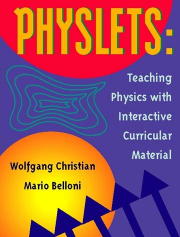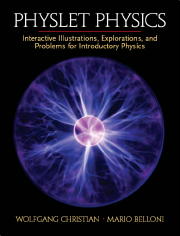See:
Description
| Packages | |
| animator4 | Animator is designed to model particle dynamics in two dimensions. |
| bfield | BField simulates magnetic fields from coils and wires. |
| blackbody | BlackBody simulates the color and the spectral distribution of a blackbody radiator at a given temperature. |
| circuit | The circuit package contains five Physlets to solve common ac and dc circuit problems: IVApplet, IZApplet, LoadApplet, LRCApplet, and RCApplet. |
| dataGraph | The dataGraph package contains two Physlets, DataGraph and Bar packaged in the DataGraph4_.jar and the Bar4_.jar files, respectively. |
| dataTable | DataTable is designed to be used as a data-listener in order to show a row-column table of numbers. |
| diatomic | Diatomic models a mixture of monatomic and diatomic molecules. |
| doppler | Doppler simulates the relativistic and classical Doppler effect. |
| edu.davidson.tools | |
| eField4 | EField displays the electric potential from point charges. |
| emwave4 | EMWave allows users to show the relationship between electric and magnetic fields in a traveling E&M wave. |
| energyEigenvalue | EnergyEigenvalue uses the shooting method to solve the time independent Schrödinger equation in order to find the energy eigenfunction and and its eigenvalue. |
| faraday | Faraday models the current induced in wires moving in an external magnetic field. |
| hydrogenic | The hydrogenic package contains three Physlets to designed to display radial wave functions, angular wave functions, and probability density plots. |
| impedance | Impedance models the frequency response of circuits consisting of resistors, capacitors, and inductors. |
| lorentz | Lorentz models the electric and magnetic fields from a moving point charge. |
| minkowski | Minkowski shows the Lorentz transformation of the spacetime grid. |
| molecular | Molecular contains four kinetic theory applets using a hard disk model. |
| optics | OpticsApplet allows users to simulate standard optic elements (lens, mirror, dielectrics, sources, apertures) and observe the ways that light rays propagate through these elements. |
| poisson | Poisson solves the boundary value problem for conductors and simple charge-density distributions using the relaxation method. |
| qTime | QTime solves the time dependent Schrödinger equation in one dimension. |
| reflection | Reflection models interference effects as waves pass through various layers. |
| ripple | Ripple models a water-filled tank containing one or more point-source exciters. |
| slider | Slider uses JavaScript <-> Java communication using the JSObject. |
| superposition | Superposition shows the time dependence of two waves and their sum. |
| sync | Sync models the electric field from an accelerating point charge including the time retardation. |
Physlets, Physics Applets, are small flexible Java applets designed for physics education.
 |
 |
Teachers wishing to develop their own Physlet-based curricular material should consult the Physlets book. Teachers whishing to assign ready to run Physlet-based material should use the Physlet Physics book. Physlet Physics contains over 800 ready-to-run Physlet-based Illustrations, Explorations, and Problems.
Physlets (the applets themselves) are free for non-commercial use. Teachers may write your own curricular material using Physlets and post this material and the Physlet on the Internet.
Published Physlet-based curricular (the narrative accompanying the applet) may be copyrighted. Please contact the copyright holder for permission to use or post copyrighted material. Conditions of use for material written by Wolfgang Christian and Mario Belloni are described in the Physlets and the Physlet Physics books published by Prentice Hall and on the Davidson College Physlet website.
Translations
Physlet-based curricular material is html based and is therefore easy to translate to other languages. Visit the following websites for additional information including non-English language Physlet books.
| Language | Website | Book |
| Chinese | ||
| Czech | ||
| German | http://pen.physik.uni-kl.de/physlets/ | German information goes here! |
| Portuguese | ||
| Spanish | http://fem.um.es/Fislets/ | Fislets book information goes here! |
| Slovenian | ||
| Slovakian | http://colos1.fri.uni-lj.si/fizleti |
List of Physlets
Animator was originally designed for the Animation of geometric shapes and images along predefined trajectories. Recent versions allow objects to move in response to particle interactions as well as external forces.
BField displays the magnetic field from straight wires or coils using color-coded vectors. External fields can also be specified.
BlackBody displays the radiation spectrum at different temperatures. The temperature can be changed by dragging the peak of the blackbody curve, by entering the value into a text field, and by scripting.
Circuits contains a collection of applets designed to model common DC and AC configurations.
DataGraph plots data sets and functions. It was designed to record data from other Physlets using real-time inter-applet communication.
DataTable displays columns of numbers. It too was designed to record data from other Physlets using real-time inter-applet communication.
Diatomic models a mixture of monatomic and diatomic molecules.
Doppler demonstrates the classical and relativistic Doppler effect. It was the first Physlet written.
EField plots fields produced by a potential function and fixed point charges. Test charges that move under the action of the field can be included in the simulation.
EMWave shows a three dimensional display of a traveling wave. The wave can be scripted to model linear as well as circularly polarized light.
EnergyEigenvalue calculates the energy spectrum of the Schrödinger equation using the shooting method and displays the wave function. Dragging the mouse inside the energy level diagram shows how only certain energy eigenvalues are able to satisfy the boundary conditions.
Faraday presents the classic problem of a wire sliding on top of a U shaped conductor embedded in a magnetic field. A galvanometer display shows the current flow as the wire is moved.
Hydrogenic contains three applets designed to display radial wave functions, angular wave functions, and probability density plots.
Impedance models the frequency response of circuits consisting of resistors, capacitors, and inductors.
Lorentz shows the electric and magnetic fields from a moving point charge.
Minkowski presents overlapping space-time diagrams for two different reference frames. Events can be attached to either frame thereby demonstrating length contraction, time dilation and other relativistic effects.
Molecular contains kinetic theory applets using a hard disk model. The basic applet, MolecularApplet, models a gas using either periodic or hard wall boundary conditions.
Optics models an optics bench with lenses, mirrors, apertures, and sources.
Poisson solves the boundary value problem for conductors and simple charge-density distributions using the relaxation method. Contour and field plot visualizations are available.
QTime solves the time dependent Schrödinger equation in one dimension. Rather than displaying separate graphs for real and imaginary components of the wave function, the amplitude is presented and color-coded to show the phase.
Reflection models wave reflections from one or more boundary layers for both E&M and quantum mechanics.
RippleTank models a water-filled tank containing one or more point-source exciters.
Superposition creates a multi-panel display containing two time-dependent waves and their sum.
Sync models the electric field from an accelerating point charge including the time retardation. Common radiation fields such as synchrotron radiation and free-electron laser wigglers are preprogrammed.
|
|||||||
| PREV NEXT | FRAMES NO FRAMES | ||||||
Visit the Davidson College Physlet Site for additional information.